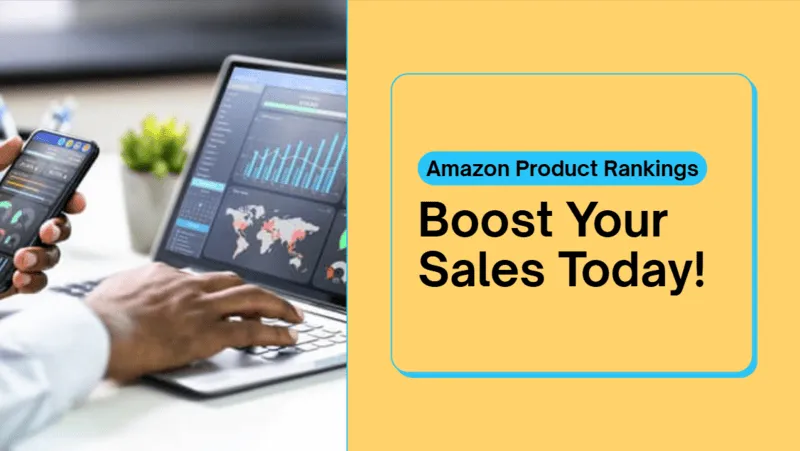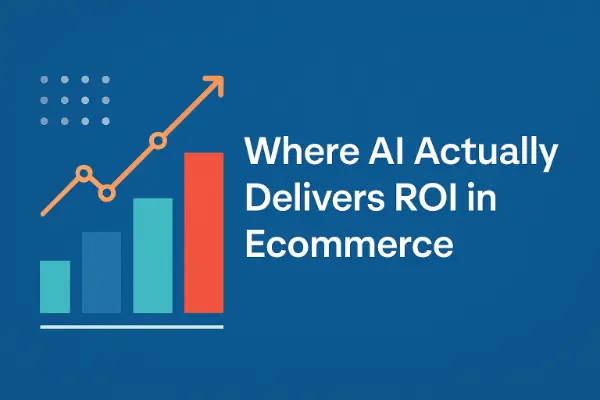How to Increase Amazon Product Rankings Before Peak Season 2025

Last updated on August 13, 2025

Peak season 2025 is looming, and boosting your Amazon product rankings should be at the top of your agenda. In the ultra-competitive Amazon marketplace, a higher Amazon sales rank can make all the difference between a blockbuster Q4 and being buried on page 5 of the search results. I’m not talking about shallow tricks or quick hacks, but sustainable, semantic-rich ranking gains that stick. Over the years, we’ve all watched Amazon’s search algorithm evolve (hello A9, A10, and now an AI-powered engine nicknamed COSMO in 2025). What worked a couple of years ago, like simple keyword stuffing, just doesn’t cut it anymore. Now it’s about genuinely optimizing for the customer’s search intent and customer satisfaction, while still checking the technical SEO boxes. Here, I’ll break down our recommended strategy for increasing Amazon product rankings ahead of the holiday rush, blending proven best practices with some fresh 2025 perspectives.
Slash Your Fulfillment Costs by Up to 30%
Cut shipping expenses by 30% and boost profit with Cahoot's AI-optimized fulfillment services and modern tech —no overheads and no humans required!
I'm Interested in Saving Time and MoneyOptimize Your Listing Keywords and Content
First things first: keyword research. To rank well, your product has to earn relevance for the right search terms. That means doing the homework on relevant keywords, both the obvious high-volume ones and the long-tail keywords that specific customers use. Dive into Amazon’s own data (the Search Query Performance dashboard in Brand Analytics) to see which search terms are driving impressions and conversions for your products. Those are gold. Sprinkle these valuable keywords strategically in your product title, bullet points, description, and backend keywords (hidden search terms). The key is balance; include important specific keywords, but don’t go overboard and trigger keyword stuffing penalties. As one Amazon expert puts it, Amazon matches your listing to searches by assessing the keywords in titles, bullet points, descriptions, and backend search terms. So, ensuring keyword relevance across these elements is critical for visibility.
Beyond keywords, make your product detail page as compelling as possible. Amazon’s algorithm increasingly uses natural language processing (the new COSMO AI) to assess content quality and search intent alignment. So write for humans first. Use bullet points that highlight key features and benefits, not just specs. Try to answer common customer questions right in the description. If someone is searching “durable kids water bottle BPA free,” your listing better say “BPA-free” and speak to durability in a conversational tone. This not only improves Amazon SEO but also conversion. And conversion (how many shoppers click buy after seeing your page) is a key factor for ranking. Amazon’s older A9 algorithm rewarded relevant keywords, but the newer A10 and COSMO reward behavioral signals, meaning if customers click your listing and actually buy (i.e., a high conversion rate), Amazon takes that as a sign your product was a great match and will rank it higher. So, optimizing the listing isn’t just about appeasing the algorithm; it’s about convincing customers you have what they need.
Don’t forget high-quality images and other media. Ensure your images are high-resolution, zoomable, and show the product from all angles (and in use-case scenarios). Images don’t directly contain keywords (aside from the alt text you can input), but they do impact sales. A set of crisp, informative images and even a video can increase conversion rates, and as mentioned, conversion feeds ranking. I focus on creating visuals that not only look good but also educate the customer (like infographics pointing out key features). The bottom line: optimize product listings with both the search algorithm and the customer in mind. Use keyword optimization to get them in the door, and quality content to keep them there.
Drive Sales Velocity with Pricing and Promotions
Sales drive rank, and rank drives sales; it’s a flywheel. One reliable way to boost your Amazon sales rank is to crank up your sales volume. Sounds obvious, but how to do it? Two words: price and promo. Take a hard look at your pricing strategy ahead of peak season. Is your price competitive for the category? If not, I might consider a strategic price drop or a coupon during the early phase of the holiday season to stimulate more sales. Amazon’s algorithm monitors sales performance and rewards products that show strong sales velocity and momentum. A product that suddenly starts selling faster than its peers can climb in rankings quickly (and conversely, running out of stock or slowing down can tank your rank). So I may suggest sacrificing a bit of margin short-term by setting competitive prices (or offering a lightning deal) to drive volume and increase sales, knowing it can pay off in organic visibility.
Looking for a New 3PL? Start with this Free RFP Template
Cut weeks off your selection process. Avoid pitfalls. Get the only 3PL RFP checklist built for ecommerce brands, absolutely free.
Get My Free 3PL RFPPromotions and Advertising are the other levers. Plan to unleash some Amazon PPC ads (Pay-Per-Click campaigns) to boost visibility for important keywords. Sponsored Products ads can put you on page 1 even before your organic rank is there, and those ad-driven sales indirectly boost your organic rank over time. Use keyword-targeted campaigns for your main keywords to get incremental sales. But do this carefully, focusing on relevant terms so you don’t blow money on clicks that don’t convert. The goal is to improve organic standing, not just pay for sales. Also, leverage deals or Amazon coupons to entice shoppers; those little green badges can improve click-through rate. A higher click-through and conversion rate from such promos signals to Amazon that shoppers are interested. It’s worth noting, Amazon’s A10 algorithm (and presumably COSMO) gives weight to external traffic and overall performance, not just pure PPC. Some of my clients run targeted Google Ads or social media campaigns pointing to their Amazon listings. This can drive a burst of external traffic that, if converting, might give a rank bump (Amazon loves when you bring in new shoppers from outside).
Crucially, avoid any black-hat tricks that could get you penalized. Instead, focus on real customer engagement: maybe an email to your past customers saying “Check out our holiday sale on Amazon” to drive legitimate traffic. By combining smart pricing, promotions, and advertising, you should generate a steady surge in sales. Industry experts note that products with a strong sales history and high conversion rates tend to rank higher, so that’s exactly what you’re trying to cultivate going into peak season.
Prioritize Reviews and Customer Satisfaction
No surprise here: positive reviews play a huge role in Amazon rankings. They are both a direct factor (Amazon knows that products with higher ratings and more reviews tend to convert better) and an indirect one (they improve conversion, which improves rank). Make it a priority to keep the customers searching for your products satisfied at every step, so that you naturally accumulate more positive reviews. How? Start with product quality; nothing kills your rank faster than a swath of bad reviews due to a flimsy product. Perform quality checks like crazy and set realistic expectations in the listing to avoid negative feedback. During peak season, ensure your customer service is on point: fast responses to questions, helpful communication, and if there’s an issue, making it right. Happy customers = happy customers who might leave a good review and are less likely to return the product.
Amazon has cracked down on review shenanigans, so only use legit methods to get reviews. For instance, use Amazon’s “Request a Review” button (or an automated tool to trigger it) for each order, which sends an official email to buyers politely asking for a review. Even a modest 1–2% of buyers leaving reviews is great when volume spikes. More reviews (and recent ones) not only improve rank but also make Amazon shoppers more likely to purchase, feeding the cycle. Keep an eye on the customer reviews you’re getting, both star rating and content. The new Amazon algorithm (COSMO) even analyzes review content for sentiment and to see if the reviews match the product claims. This is next-level stuff: if your listing says “ultra quiet blender” and a bunch of reviews say “this blender is noisy,” I suspect Amazon will ding you in search for over-promising. So use that as feedback to improve the product or copy.
Importantly, customer experience after the sale matters too. Returns, order defects, and late shipments reflect dissatisfaction. Amazon’s algorithm might indirectly penalize listings with a high return rate or poor seller metrics (especially if you’re FBM or SFP). Aim for a smooth ride for customers from click to delivery. In fact, at Cahoot, we’ve seen that fast, reliable fulfillment leads to happier customers and better reviews. If you can offer Prime-like shipping speeds (whether via FBA or a Seller Fulfilled Prime model), customers are delighted, and you reduce negatives. Every bit of inventory management and fulfillment excellence feeds back into positive outcomes like good reviews and low returns.
Scale Faster with the World’s First Peer-to-Peer Fulfillment Network
Tap into a nationwide network of high-performance partner warehouses — expand capacity, cut shipping costs, and reach customers 1–2 days faster.
Explore Fulfillment NetworkManage Inventory and Fulfillment Meticulously
It would be a shame to do all this work to boost rank, only to go out of stock when demand hits. So inventory planning is absolutely part of ranking strategy. An OOS (out-of-stock) product loses its sales momentum and its ranking can plummet, and often takes time to recover even after restock. To avoid that, analyze last year’s sales and current trends to forecast how much stock you’ll need for the season (plus a safety buffer). Make sure to send inventory into FBA well in advance of the rush, so it’s checked in and ready to ship when orders pour in. If Amazon has restock limits for your SKUs, consider using a backup like a multi-channel fulfillment partner or 3PL to hold overflow inventory and drip-feed Amazon as needed, or even fulfill some FBM (Fulfilled by Merchant) orders if your FBA sells out. The key is never saying “Currently unavailable” during the peak! That’s a fast-track to losing the rank gains you fought so hard for.
Fulfillment speed and reliability also count toward customer happiness and indirectly affect ranking. If you fulfill via FBA, you’re generally good. Prime shipping gives you a conversion edge. If you’re doing FBM or Seller Fulfilled Prime, ensure you meet those shipment and delivery promises. Late deliveries can hurt seller metrics, and while Amazon’s search algorithm mostly focuses on product performance, extreme lateness or cancellations could impact your Buy Box and indirectly your visibility. Consider leaning on Cahoot’s network of warehouses to achieve 1–2 day delivery across the country for non-FBA orders, which helps you compete with FBA sellers in terms of shipping. It’s something many Amazon sellers overlook; fast shipping can improve customer satisfaction and thus your product’s success metrics, both FBA and non-FBA.
Another aspect of inventory management is staying on top of your catalog. If you have variations (sizes, colors), keep stock healthy on all the popular variants. Amazon can sometimes rotate the “main” child ASIN that shows up in search based on availability and sales. You don’t want your one variant that’s ranking well to go OOS and be replaced by a less attractive variant in search results. Also, consider whether you need to throttle ads if stock is running low; no point paying for rank only to run dry. In summary, a well-stocked, well-distributed inventory with robust fulfillment processes is the backbone of maintaining a good sales rank during peak season. Inventory is tied to sales performance: no inventory, no sales; and no sales, no rank. So treat inventory planning as part of your SEO work in a sense.
To me, the recipe is clear: optimize like a human (use good keywords and content), deliver great value (through price and service), keep customers happy, and the rankings will follow. It’s many moving parts, but when it all comes together, you set yourself up to dominate Amazon’s search results during the holiday frenzy.
Frequently Asked Questions
What factors most influence how to increase Amazon product rankings?
Keyword relevance, sales volume, sales velocity, conversion rates, customer satisfaction, and positive reviews all play key roles in improving Amazon’s sales rank and search results placement.
How can keyword research improve my Amazon sales rank?
Using keyword research tools to identify relevant keywords and long-tail keywords, then placing them in the product title, bullet points, backend keywords, and product detail page increases keyword relevance and visibility in Amazon’s search algorithm.
Do customer reviews affect Amazon search rankings?
Yes. Positive reviews play a major role in improving conversion rates and customer trust, which increases sales performance. More positive reviews signal to Amazon that your listing matches customer search intent, helping to rank on Amazon for targeted keywords.
What role does pricing play in Amazon SEO?
Competitive pricing helps drive more sales and sales velocity. Combined with keyword optimization, this can improve Amazon’s sales rank in the same category, especially during peak season when shoppers compare offers closely.
Why is inventory management important for improving Amazon rankings?
Consistent inventory management prevents stockouts, maintains strong sales history, and ensures customers see fast delivery options. This supports customer satisfaction and protects rankings in Amazon’s search results.

Turn Returns Into New Revenue


 8 minutes
8 minutes


